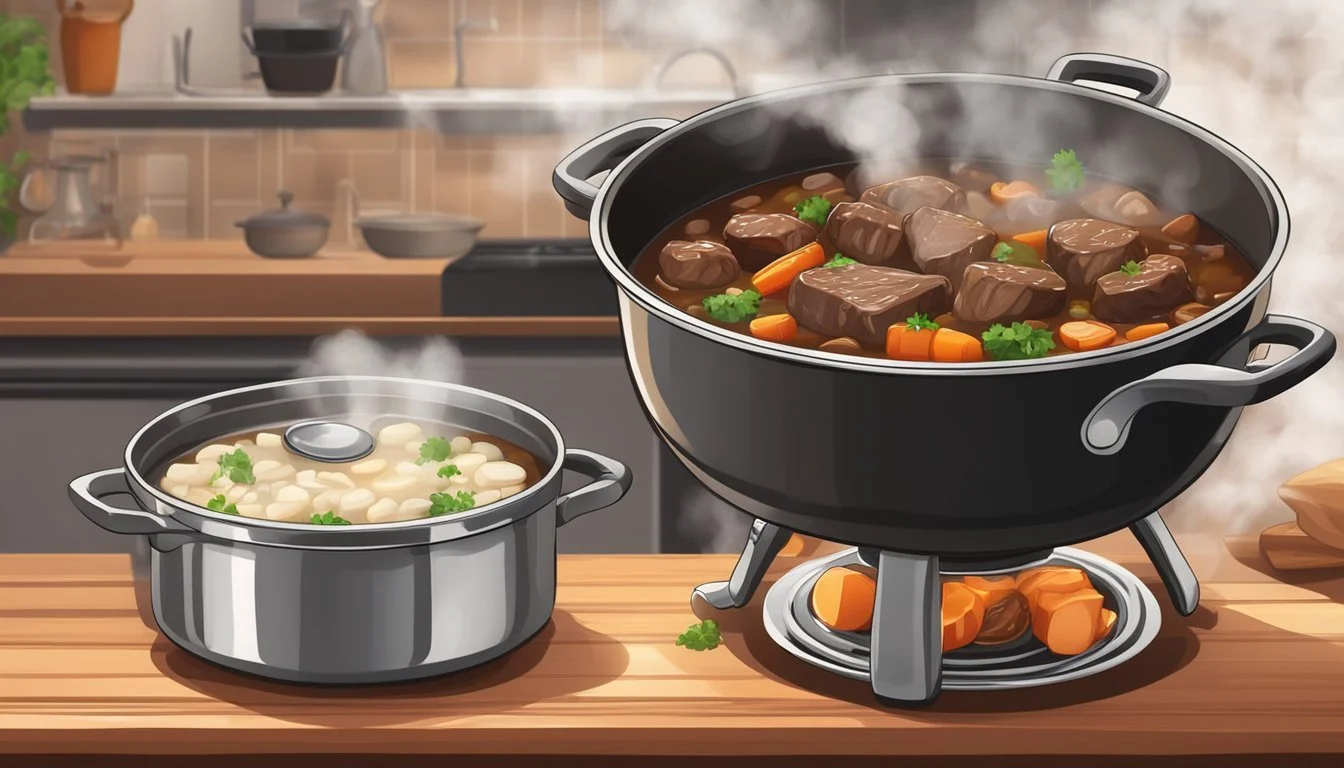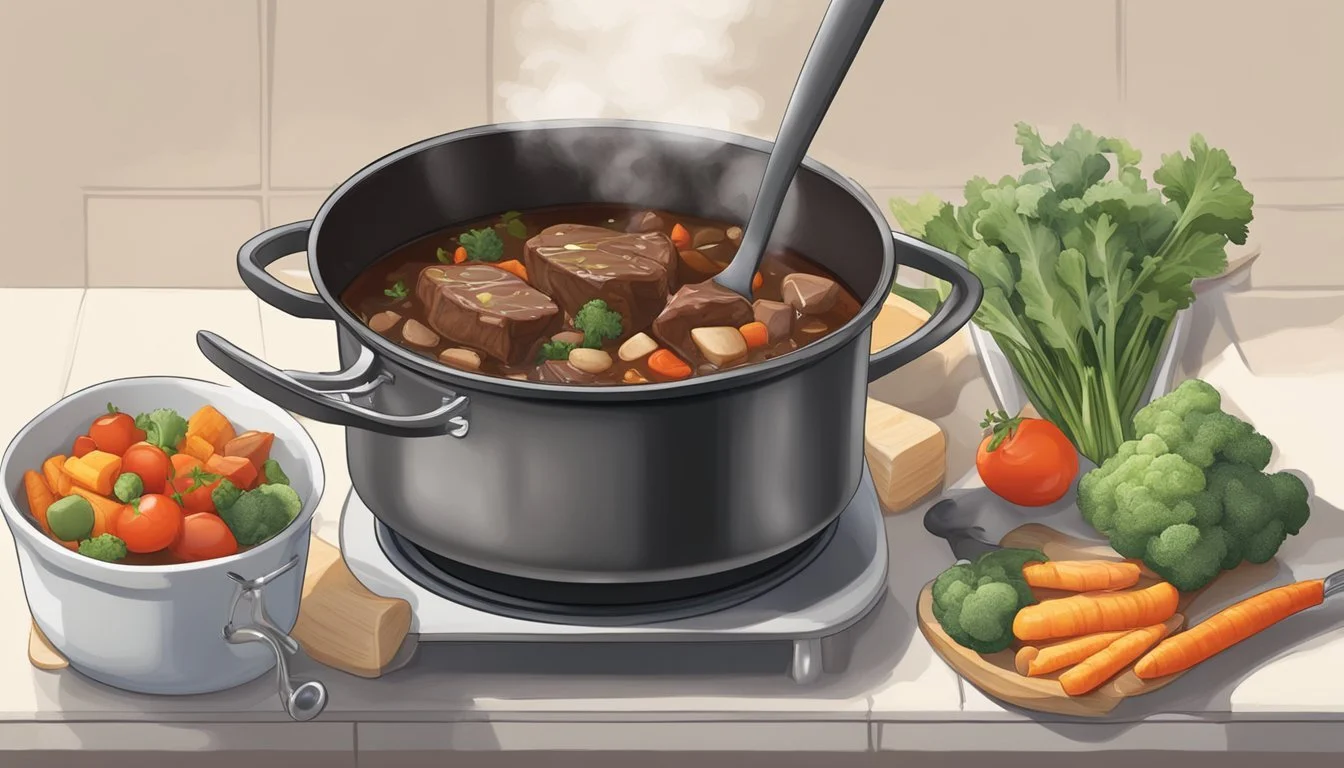How to Reheat Beef Bourguignon
Expert Tips for Delicious Leftovers
Reheating Beef Bourguignon can seem like a challenge, but with a few simple techniques, you can enjoy this rich and delicious dish as if it were freshly made. To start, the oven is a reliable method for reheating Beef Bourguignon, ensuring even heating without compromising the dish's rich flavors and tender meat. Preheating the oven and using an oven-safe dish with a cover will help retain moisture and prevent drying out.
Using the microwave is a quicker alternative perfect for individual portions or when you're short on time. Setting the microwave to medium power and heating in short bursts helps avoid overcooking and uneven heating. Dividing larger portions into smaller ones also ensures uniform heating and maintains the dish’s quality.
Lastly, remember to thaw frozen Beef Bourguignon properly in the refrigerator to prevent bacterial growth. Bringing the stew to room temperature before reheating will also ensure a more consistent result. With these practical tips, anyone can enjoy this classic French dish just as it was intended.
Understanding Beef Bourguignon
Beef Bourguignon is a classic French dish known for its rich flavors and hearty ingredients. This section explores its origins, key components, and distinctive taste profile.
Origins and Popularity
Beef Bourguignon originated from the Burgundy region of France. Traditionally, it was a peasant dish made with cheaper cuts of beef, slow-cooked to tender perfection in red wine. Over time, it has become an iconic French dish celebrated worldwide.
Julia Child, a renowned chef, popularized Beef Bourguignon in the United States with her cookbook "Mastering the Art of French Cooking."
Today, it is cherished for its depth of flavor and classic preparation method.
Key Ingredients
The ingredients of Beef Bourguignon are simple yet essential to its depth of flavor. Beef, preferably a braising cut like chuck or brisket, is the star of the dish, absorbing the rich flavors of the cooking liquid.
Red wine from Burgundy plays a critical role, providing the characteristic robust taste.
Other ingredients include:
Bacon: Adds a smoky, salty element.
Mushrooms: Offer earthiness and texture.
Pearl Onions, Carrots, and Garlic: Contribute sweetness and aromatics.
Thyme and Bay Leaves: Enhance the herbal notes.
Tomato Paste: Adds complexity and a slight tanginess.
Flavor Profile
Beef Bourguignon is renowned for its rich, layered flavors. The long, slow cooking process melds the beef with the wine and aromatics, creating a deeply flavorful and savory dish.
The wine-based sauce thickens into a hearty, velvety consistency, infusing every bite with robust red wine flavors.
Black pepper and herbs like thyme and bay leaves provide subtle spice, while ingredients like bacon and mushrooms add depth and umami. The addition of tomato paste introduces a mild acidity, balancing the richness. Each ingredient comes together in harmony, offering a satisfying, well-rounded taste.
The result is a dish that is comforting, flavorful, and perfect for both casual dinners and special occasions.
Preparation for Reheating
Properly storing and preparing your beef bourguignon for reheating ensures that it retains its flavor and quality. This process involves optimal storage methods and crucial pre-reheating steps to guarantee a delightful meal.
Optimal Storage
For the best results, store beef bourguignon in an airtight container. This prevents air from affecting the dish's quality and flavor. If refrigerating, place the container in the refrigerator promptly after cooling to prevent bacterial growth. For longer storage, consider freezing the dish.
When using plastic wrap, ensure it doesn’t touch the food directly to avoid potential chemical leaching. Alternatively, cover the container with aluminum foil. Clearly label the container with the storage date.
Pre-Reheating Steps
Before reheating, thaw any frozen beef bourguignon in the refrigerator, allowing 5-6 hours per pound. This gradual thawing prevents bacterial growth that can occur at room temperature.
Transfer the stew into an oven-safe dish if using the oven for reheating. Adding a bit of liquid, like stock, helps maintain the dish's moisture. Use aluminum foil to cover the dish, retaining heat and moisture during reheating.
Reheating Techniques
Knowing how to properly reheat Beef Bourguignon ensures that the dish retains its rich flavor and texture. The methods discussed are tailored to different kitchen appliances and needs, from the oven to the microwave.
Oven Reheating Method
Preheat the oven to 325°F (165°C). Transfer the Beef Bourguignon to an oven-safe dish and cover it with foil or a lid to retain moisture. Place the dish in the preheated oven.
Reheat for 20-30 minutes. Check halfway through to stir the stew and ensure even heat distribution. If the sauce appears dry, add a few tablespoons of stock or water. This method uses gentle heat to preserve the dish's complexity.
Regular stirring helps avoid cold spots and guarantees that the dish heats evenly. This method is excellent for preserving the robust flavors and tender texture of the Beef Bourguignon.
Stovetop Reheating Strategy
For those preferring stovetop reheating, transfer the stew to a pot or Dutch oven. Set the heat to medium-low, ensuring the flame is neither too high nor too low.
Add a few tablespoons of stock or water to the pot to maintain the dish’s consistency. Stir gently to promote even heating. Reheat for about 5-7 minutes until bubbling and then let it simmer for another 2-3 minutes.
This technique is efficient for reheating while still preserving the stew’s rich, savory flavors. Stirring occasionally ensures the dish heats uniformly, preventing any parts from drying out.
Microwave Reheating Tips
Microwave reheating is suited for individual portions. Place the Beef Bourguignon in a microwave-safe container. Cover it with a microwave-safe lid or vented plastic wrap to trap steam and retain moisture.
Set the microwave to 50% power or medium. Heat the dish initially for 3-4 minutes. Stir halfway through to ensure even heating. For larger portions, it’s advisable to divide them for uniform heating.
If needed, add a small amount of liquid to keep the stew from drying out. Use this method only when short on time, as it might slightly alter the dish’s texture compared to other methods.
Using a Slow Cooker
For a more hands-off approach, use a slow cooker to reheat Beef Bourguignon. Set the slow cooker to low heat. Transfer the stew into the cooker and cover with the lid.
Reheat for 1-2 hours, stirring occasionally. This method ensures** gentle, even heat distribution** and helps in retaining moisture and flavor.
Featuring a slow, low heat allows the stew to reheat without compromising the tender texture of the meat and the depth of the flavors. This technique is perfect for when you have a bit more time and want to preserve the dish's original quality.
Maintaining Quality and Safety
To reheat Beef Bourguignon effectively, focus on precise temperature control, avoiding contamination, and preventing overcooking. These steps ensure the dish retains its taste, texture, and moisture while minimizing any food safety risks.
Temperature Control
Accurate temperature control is essential for preserving the dish's quality. Use a food thermometer to monitor the internal temperature, aiming for around 165°F (74°C) to ensure the dish is heated through without drying out.
When reheating in the oven, preheat to 325°F (165°C) and cover the dish with foil to help maintain moisture. If using a microwave, set the power level to 50% or medium and check every few minutes. Stir occasionally to ensure even heating and prevent hot spots.
Avoiding Contamination
Avoiding contamination is key to reheating safely. Always thaw frozen Beef Bourguignon in the refrigerator for 5-6 hours per pound to minimize bacterial growth risk. Never thaw at room temperature as it can lead to unsafe conditions.
Ensure any utensils or containers used are clean and sanitized. When reheating in the microwave, cover the dish to prevent any airborne contaminants from settling. Avoid using plastic wrap directly on the food to prevent hazardous melting that can affect food quality.
Preventing Overcooking
Overcooking can ruin the texture and taste of Beef Bourguignon. Reheat the dish gently to retain its moisture and prevent the fat from becoming overly greasy. Use lower temperatures and longer cooking times for more even heat distribution.
For smaller portions, reheating in the microwave is quicker but requires careful monitoring. Heat in short intervals and stir regularly to keep the dish from drying out. For larger portions, the oven method is preferable. Check halfway through and add a bit of broth if the stew seems dry. This keeps the texture tender and preserves the flavors.
Serving Suggestions
Pairing and finishing Beef Bourguignon with the right elements can elevate your dining experience significantly. Explore accompaniments and final touches to transform a simple reheated dish into a restaurant-quality meal.
Accompaniments
Mashed Potatoes: Smooth and creamy mashed potatoes are a classic pairing, providing a comforting base that complements the rich, hearty flavors of Beef Bourguignon.
Bread: A crusty baguette or a slice of sourdough bread is perfect for soaking up the delicious sauce. For added flavor, lightly butter the bread and toast it.
Potatoes: Roasted or boiled baby potatoes with a sprinkle of fresh parsley can add texture and flavor that enhance the dish's richness.
Rice: A bowl of fluffy jasmine or basmati rice works well, absorbing the stew's flavorful broth, making each bite more satisfying.
Noodles: Wide egg noodles or tagliatelle give a wonderful contrast in texture and are excellent at holding onto the savory sauce.
Final Touches
Fresh Parsley: Sprinkling fresh parsley over the Beef Bourguignon adds a burst of color and a hint of freshness that brightens up the dish.
Garnish: Garnish with a few sprigs of thyme or rosemary. These herbs not only enhance the aroma but also add depth to the flavor profile.
Seasoning: After reheating, taste the beef bourguignon and adjust the seasoning. A bit of salt and pepper can revitalize the flavors, and a squeeze of lemon can add a subtle zest that balances the richness.
Butter: Swirling in a small knob of butter just before serving can make the sauce even more luxurious and glossy, enhancing the dining experience.
These thoughtful additions and adjustments ensure that your reheated Beef Bourguignon is as delightful as when it was first prepared.
Additional Tips and Tricks
Reheating Beef Bourguignon can be optimized with a few key techniques to enhance flavor, manage leftovers, and properly freeze and thaw the dish.
Enhancing Flavor After Reheating
To amplify the flavor after reheating, incorporate fresh herbs such as parsley, thyme, or a bay leaf. Adding a small amount of red wine or beef broth can restore some of the dish’s original depth. Stirring with a wooden spoon helps ensure flavors mix well without damaging the meat and vegetables.
A dash of vinegar or a squeeze of lemon juice can also brighten the taste. These simple ingredients can reintroduce complexity to the reheated stew.
Dealing with Leftovers
Leftover Beef Bourguignon can be stored effectively to retain its quality. Keep leftovers in airtight containers to maintain moisture. When reheating leftovers, smaller portions tend to heat more evenly.
Microwaving can be useful for individual portions—heat at 50% power to avoid overcooking. Stir occasionally to distribute heat evenly and maintain consistency.
Freezing and Thawing Advice
When freezing Beef Bourguignon, divide it into smaller portions for quicker thawing. Store in freezer-safe containers or heavy-duty freezer bags. For long-term storage, incorporate a layer of plastic wrap between the dish and lid to prevent freezer burn.
Allow frozen leftovers to thaw in the refrigerator for 5-6 hours per pound. Avoid thawing at room temperature to prevent bacterial growth. Once thawed, reheat gently on the stove, adding a bit of water or beef broth to maintain consistency. Stir occasionally with a wooden spoon to ensure even cooking.





